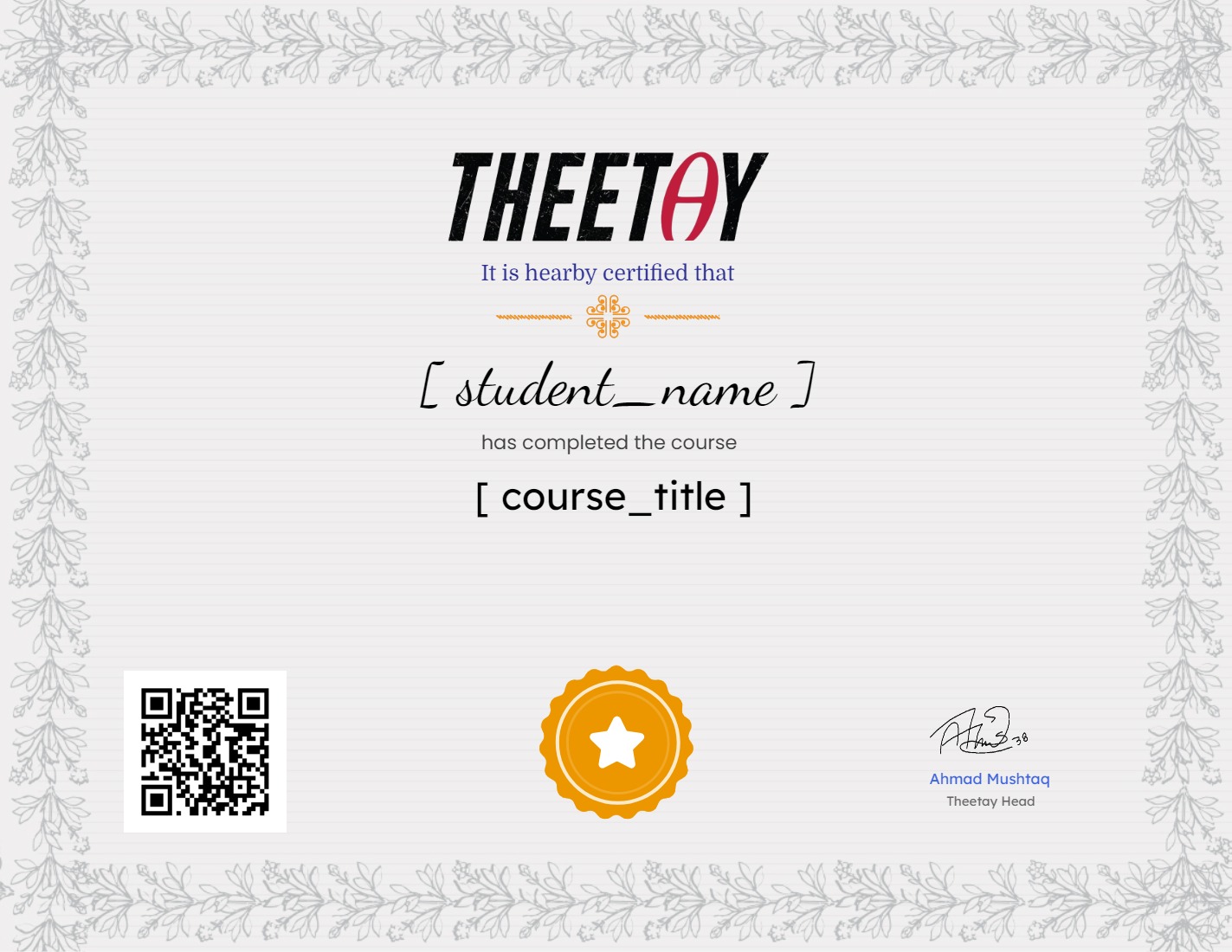(Udemy) ANSYS from Drawing to Results Visualization – CFD and FEA (Mahmoud A.A.M)

About Course
This free ANSYS course, offered through Udemy, takes you from drawing to results visualization, covering both CFD (Computational Fluid Dynamics) and FEA (Finite Element Analysis).
Start with a solid foundation: This course lays out the essential fundamentals and basics of simulation and CFD in an engaging and accessible way. Learn how to use DesignModeler with high-quality, well-organized content and step-by-step examples.
Master meshing: Get a thorough understanding of ANSYS Meshing, with a structured approach that simplifies the process and guides you toward creating high-quality, structured hexa meshes. The course includes animated presentations for the meshing theory and three custom tools to optimize your meshing.
Solve real-world problems: Apply your skills to five real-world examples, including a special experimentally validated example simulating solar load. Use ANSYS Mechanical Thermal, ANSYS Mechanical Structural, and ANSYS FLUENT to solve these applications. One example features parametric analysis, showcasing the power of ANSYS Workbench and the diverse results you can obtain.
The course verifies the results of the first four examples through analytical calculations and empirical correlations. The final example is validated against experimentally measured data for a box solar cooker, using both experimental inputs and a solar calculator.
Practice makes perfect: Practice exercises are included throughout the course, helping you master the key concepts in each section.
Enroll now and unlock your potential in the world of CFD and FEA with ANSYS!
What Will You Learn?
- In-detailed explanation of DesignModeler & ANSYS Meshing
- In-detailed five examples of real-life applications using ANSYS Mechanical & ANSYS FLUENT
- ANSYS Workbench
- Parametric Analysis
- Basic simulation and CFD fundamentals
- Basics of schematic diagrams infographic designing and representation for scientific targets using Adobe Illustrator and PowerPoint.
- Exporting results files in a high quality and proper formats as recommended by the scientific research journals.
- How to save ANSYS project with different formats
Course Content
Course Overview
-
Introduction
01:51 -
A Message from the Professor
-
Course Material Download Link
00:00
Things You Should Know before Starting the Course
-
Important Concepts
07:31 -
Engineering Problems Solving Methods
02:28 -
Numerical Solving Methods
05:12
Important Fundamentals
-
ANSYS Important Concepts
01:25 -
Types of Problems
06:17 -
ANSYS Solvers Common Types and Systems Couplings
09:20 -
Basics of Drawing Figures and Schematics in PowerPoint Part I
14:58 -
Basics of Drawing Figures and Schematics in PowerPoint Part II
26:36 -
Basics of Drawing Figures and Schematics in PowerPoint Part III
01:25 -
Basics of Drawing Figures and Schematics in PowerPoint Part IV
05:05 -
Basics of Drawing Figures and Schematics in Adobe Illustrator
23:27 -
Solving ANSYS Problems – Methodology
07:30 -
Assignments Submission Steps
02:47 -
How We Make Our Presentations (NEW)
14:10
Design Modeler (DM)
-
DesignModeler Overview
10:21 -
Draw Toolbox
11:41 -
Modify Toolbox
19:44 -
Dimensions Toolbox
13:21 -
Constrains Toolbox
09:39 -
Types of Bodies in DesignModeler – Overview
03:24 -
Line Body Generation
09:11 -
Surface Body Generation
07:44 -
Split Edges
04:05 -
New Planes and Solid Body Generation
10:03 -
Drawing in Space Tool
01:36 -
Extrude and Revolve
13:25 -
Sweep and Loft – Part I
03:04 -
Sweep and Loft – Part II
04:59 -
Fillet and Chamfer
02:14 -
Mirror Pattern and Scale
10:50 -
Surface Extension and Flip
04:10 -
Patch Delete and Symmetry
14:56 -
Slice Projection and Face Split – Part I
10:25 -
Slice Projection and Face Split – Part II
11:13 -
Named Selections
08:15 -
Parametric Analysis Overview – Part I
13:36 -
Parametric Analysis Overview – Part II
13:54 -
Joints and Multibody Part
10:22 -
Analysis Tools
08:52 -
Cleanup and Repair of Geometry – Part I
06:30 -
Cleanup and Repair of Geometry – Part II
04:31 -
Boolean Enclosure
05:31 -
Boolean Enclosure
15:24 -
Boolean Enclosure
09:50 -
Translate Rotate and Move
05:01 -
Saving the Geometry Project
01:44
ANSYS Meshing
-
Meshing Overview
04:14 -
ANSYS Meshing_2019_R2 – Introduction
11:27 -
ANSYS Meshing_R15.0 – Introduction
08:21 -
Two-Dimensional Geometries Meshing
01:12 -
Mappable Faces VS Unmappable Faces in ANSYS
03:55 -
2D Meshing Methods – Quadrilateral Dominant
08:27 -
2D Meshing Methods – Triangles
01:50 -
2D Meshing Methods – MultiZone Quad Tri
09:37 -
Three-Dimensional Geometries Meshing Overview
01:34 -
3D Meshing Methods – Tetrahedrons
04:35 -
3D Meshing Methods – Hex Dominant
06:57 -
3D Meshing Methods – Sweep
14:16 -
3D Meshing Methods – Automatic
02:17 -
Mapped Unmapped
02:14 -
2D Mapped Mesh Introduction
02:41 -
3D Mapped Mesh Introduction
00:55 -
2D Free Mesh Introduction
03:21 -
3D Free Mesh Introduction
00:55 -
Generation of Hexa (Mapped) Mesh
04:39 -
Selection of Suitable Mesh Introduction
03:31 -
Mapped Meshing – Example 1
10:57 -
Mapped Meshing – Example 2
03:42 -
Mapped Meshing – Example 3
02:34 -
Mapped Meshing – Example 4
04:21 -
Mapped Meshing – Example 5
06:39 -
Mapped Meshing – Example 6
10:39 -
Conformal and Non-conformal Mesh
02:54 -
Is Your Meshing Good Enough
01:53 -
Mesh Resolution
05:18 -
Mesh Smoothness and Transition
03:11 -
Mesh Sizing – 2D Geometries
16:52 -
Mesh Sizing – 3D Geometries
05:11 -
Importance of Y+
06:09 -
Element Order
06:26 -
Gradual Change in Mesh Size Overview
02:06 -
Meshing Parameters Optimization Tools
05:05 -
Gradual Mesh Sizing – Structured Mesh
10:45 -
Gradual Mesh Sizing – Unstructured Mesh
05:02 -
Mesh Quality
05:05 -
Mesh Dependency Test and Meshing Parametric Analysis
01:14 -
Saving ANSYS Meshing Project
01:29
Project 1_ Linear Heat Conduction Apparatus Simulation
-
Problem Specifications Summary
04:18 -
Creating the ANSYS Project Folder
01:09 -
Engineering Data
04:54 -
Creating the Geometry
05:28 -
Meshing and Boundary Conditions
07:14 -
Results Visualization – Temperature Distribution Plot
06:59 -
Results Visualization – Heat Flux Contours
05:20 -
Results Visualization – Heat Transfer Flow
02:54 -
Results Visualization – Temperature at Interface
02:11 -
Results Visualization – Directional Heat Flux Color Map
01:30 -
Results Visualization – Temperature Contours (I)
05:37 -
Results Visualization – Temperature Contours (II)
04:45 -
Results Visualization – Temperature Distribution Plot (Case II and Case III)
03:57 -
Saving ANSYS Project
02:20
Project 2 _ Critical Radius of Insulation for a Cylinder Using Parametric Study
-
Problem Description
05:08 -
Engineering Data
03:05 -
Creating the Geometry
04:36 -
Meshing
03:23 -
Boundary Conditions
02:07 -
Parametric Analysis – Part I
04:07 -
Parametric Analysis – Part II
03:02 -
Plotting in Excel
05:35 -
Saving the Project
00:25
Project 3_ Bending Moment and Shear Force Diagrams for a Cantilever Beam
-
Problem Description
02:26 -
Creating the Geometry
02:30 -
Meshing and Boundary Conditions
02:15 -
Results Visualization – Shear Moment and Bending Diagrams
03:56 -
Results Visualization – Directional Deformation
01:15
Project 4_ Flow Over a Heated Flat Plate
-
Problem description and analytical calculations
07:23 -
Geometry and named selections
06:32 -
Mesh generation
08:17 -
Starting ANSYS FLUENT
03:54 -
Fluent General window settings Part I
03:31 -
Fluent General window settings Part II
02:25 -
Selecting the suitable Models and governing equations
02:58 -
Setting the material properties and cell-zone conditions
02:01 -
Boundary conditions
03:20 -
Should we activate the dynamic mesh
00:32 -
Reference values
01:08 -
Solution methods
02:07 -
Solution controls
00:43 -
Residual monitors
01:27 -
Solution initialization
06:04 -
Run calculation
04:22 -
Saving the project
01:59 -
How to export high quality pictures from FLUENT
01:13 -
How to export the Residuals plot as a high quality picture
05:41 -
Results graphics – Temperature contours and colormap settings
05:50 -
Results graphics – Pressure coefficient contours
01:17 -
Results graphics – Velocity contours and vectors
08:16 -
Results reports – Verify area
02:46 -
Results reports – Average Nusselt Number
02:04 -
Results reports – Average convection heat transfer coefficient
01:04 -
Results reports – Average friction coefficient
00:42 -
Local convection heat transfer coefficient
11:25 -
Local skin friction coefficient
01:57 -
Results plot – Velocity profile
04:43 -
Creating plots from FLUENT for research articles using Excel
09:51 -
Point line and isosurface operations
07:12 -
Results plot – Temperature profile
03:22 -
Report definitions report files and report plots
03:59 -
Expressions – The UDF alternative
08:43 -
ANSYS FLUENT parametric analysis
01:47 -
Export import and compressing of case & data files
02:51 -
Export cdat files for CFD-Post
01:26 -
Save and archive the project
00:52
Project 5_ Simulation of a Box Solar Cooker Using Solar Load Methods
-
Problem description
05:23 -
Geometry and named selections – Part I
06:05 -
Geometry and named selections – Part II
05:26 -
High quality mesh generation
07:06 -
Preparing systems for the simulation methods
01:20 -
Starting ANSYS FLUENT for the experimental inputs-based simulation – Method I
01:21 -
Fluent General settings – Mesh Display
00:53 -
Fluent General settings – Selecting the suitable solver type
01:18 -
Fluent General settings – Time settings
00:15 -
Fluent General settings – Gravity
00:44 -
Fluent General settings – Mesh check mesh size info and report quality
01:23 -
Selecting the suitable (Models) and governing equations for Method I
04:41 -
Start journal file recording to automate settings for solar calculator method
01:14 -
Setting the material properties and cell-zone conditions
02:41 -
Boundary conditions and shell conduction model
02:25 -
Should we activate the dynamic mesh and Reference values
00:50 -
Solution methods
02:10 -
Solution controls and setting the suitable under-relaxation factors
00:58 -
Report Definitions
00:45 -
Residual monitors
00:33 -
Solution initialization
01:16 -
Run calculation
01:20 -
End journal file recording
02:08 -
Saving the project
01:16 -
Export the mesh as a high-quality picture from FLUENT for research purposes
01:18 -
Export the temperature contours as a high-quality picture for research purposes
02:41 -
Export solar heat flux contours as a high-quality picture for research purposes
01:07 -
Results reports – Temperature at the plate center result and validation
01:03 -
Export case and data files of experimental inputs-based ANSYS FLUENT simulation
02:53 -
Starting solar calculator-based simulation & setting general setting -Method II
00:50 -
Selecting the suitable (Models) and governing equations for Method II
04:38 -
Reading the journal file and automate ANSYS FLUENT – Part I
01:08 -
Reading the journal file and automate ANSYS FLUENT – Part II
01:47 -
How to deal with the case & data files
03:36
How to Publish a Scientific Paper Guide
-
Important Terms You Should Know
05:46
Earn a certificate
Add this certificate to your resume to demonstrate your skills & increase your chances of getting noticed.

Student Ratings & Reviews


